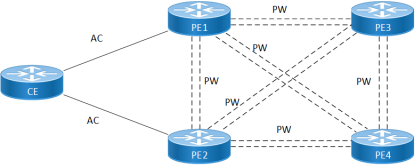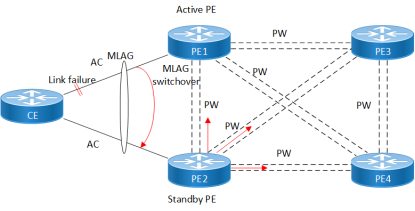MLAG Active-Standby for VPLS
Overview
The Virtual Private LAN Service (VPLS) architecture provides a multipoint ethernet connection using the Multi-Protocol Label Switching (MPLS) transport. This helps connect multiple devices from different geographical locations to the same virtual network. The Multi-Chassis Link Aggregation (MLAG) provides the redundancy technique in the VPLS architecture, making it failsafe multipoint VPLS connectivity. The redundancy in the network traffic is achieved by dual-homing a Customer Edge (CE) device to two Provider Edge (PE) devices.
A single CE is dual-homed to two PEs for redundancy is shown in the following figure:

Feature Characteristics
The Multi-Chassis Link Aggregation (MLAG) Active-Standby for VPLS feature facilitates implementation of the MLAG Active-Standby between the VPLS PE devices. This facilitates Attachment Circuit (AC) redundancy for the dual-homed Customer Edge (CE) device. This means there is one Active link and another Standby link between a CE device and the PE devices. When an Active link fails, the Standby link becomes Active with the MLAG switch, resulting in a change in topology. The change in topology requires a mac-flush in the peer devices for faster convergence. The feature also facilitates forwarding the automatic mac-flush message to all the peer nodes, reducing the convergence time when a link fails.

The above figure shows a VPLS mesh linked to a dual-homed CE connected to PE1 and PE2. The traffic flows from CE to PE3 through the active MLAG PE1, while PE2 remains a standby MLAG. When PE1 experiences a link failure, the standby MLAG becomes active, and traffic flows through the PE2 device to reach the destination PE3. Configuring the mac flush send on mlag switchover command enables MAC flush PDU tx, and PE2 automatically sends the MAC flush message to all the peer nodes PE1, PE3, and PE4 as depicted by the red arrows, which reduces the convergence time.
Consider the following point while configuring this feature:
| • | Only Active-Standby MLAG is supported. |
| • | Only flush-all-but-mine MAC-flush approach is supported. |
| • | If multiple Attachment Circuits (ACs) are mapped to the same MLAG interface, the MLAG switch is not triggered when only one or a few AC go down. |
| • | MAC flush on a remote VPLS peer is supported only when LDP signaling (not BGP signaling) is used. A MAC flush message (flush-all-but-mine) will have an empty MAC address list. An empty MAC address list will flush all the MAC addresses and cannot flush any selected MAC addresses. |
Benefit
This feature enhances the reliability of VPLS by providing redundancy using MLAG.
Prerequisites
Refer to the MLAG Configuration section in the OcNOS Layer 2 Guide.